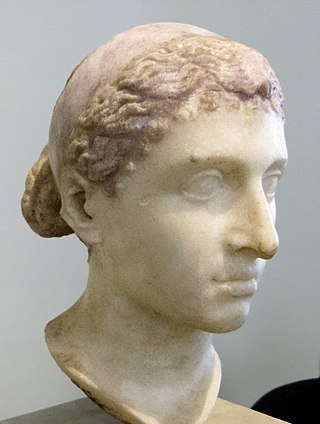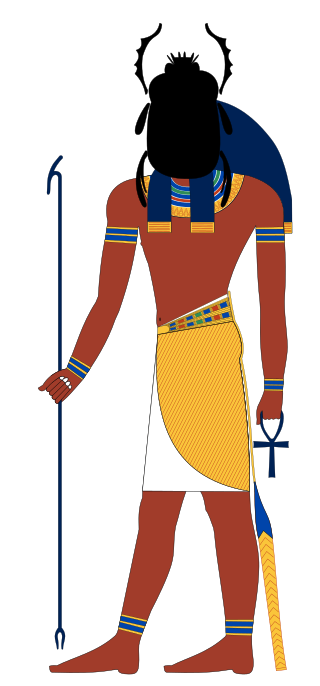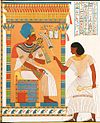Related Research Articles

Papyrus is a material similar to thick paper that was used in ancient times as a writing surface. It was made from the pith of the papyrus plant, Cyperus papyrus, a wetland sedge. Papyrus can also refer to a document written on sheets of such material, joined side by side and rolled up into a scroll, an early form of a book.

The Ptolemaic dynasty, also known as the Lagid dynasty, was a Macedonian Greek royal house which ruled the Ptolemaic Kingdom in Ancient Egypt during the Hellenistic period. Reigning for 275 years, the Ptolemaic was the longest and last dynasty of ancient Egypt from 305 until its incorporation into the Roman Republic in 30 BC.

Cleopatra VII Thea Philopator was Queen of the Ptolemaic Kingdom of Egypt from 51 to 30 BC, and its last active ruler. A member of the Ptolemaic dynasty, she was a descendant of its founder Ptolemy I Soter, a Macedonian Greek general and companion of Alexander the Great. After the death of Cleopatra, Egypt became a province of the Roman Empire, marking the end of the last Hellenistic-period state in the Mediterranean and of the age that had lasted since the reign of Alexander. Her first language was Koine Greek and she is the only known Ptolemaic ruler to learn the Egyptian language.

Thoth is an ancient Egyptian deity. In art, he was often depicted as a man with the head of an ibis or a baboon, animals sacred to him. His feminine counterpart was Seshat, and his wife was Ma'at. He was the god of the Moon, wisdom, knowledge, writing, hieroglyphs, science, magic, art and judgment.

Khepri is a scarab-faced god in ancient Egyptian religion who represents the rising or morning sun. By extension, he can also represent creation and the renewal of life.
Upper Egypt is the southern portion of Egypt and is composed of the Nile River valley south of the delta and the 30th parallel N. It thus consists of the entire Nile River valley from Cairo south to Lake Nasser.

The ouroboros or uroboros is an ancient symbol depicting a serpent or dragon eating its own tail. The ouroboros entered Western tradition via ancient Egyptian iconography and the Greek magical tradition. It was adopted as a symbol in Gnosticism and Hermeticism and most notably in alchemy. Some snakes, such as rat snakes, have been known to consume themselves.
Nubians are a Nilo-Saharan ethnic group indigenous to the region which is now Northern Sudan and Southern Egypt. They originate from the early inhabitants of the central Nile valley, believed to be one of the earliest cradles of civilization. In the southern valley of Egypt, Nubians differ culturally and ethnically from Egyptians, although they intermarried with members of other ethnic groups, especially Arabs. They speak Nubian languages as a mother tongue, part of the Northern Eastern Sudanic languages, and Arabic as a second language.
Book of Thoth is a name given to many ancient Egyptian texts supposed to have been written by Thoth, the Egyptian god of writing and knowledge. They include many texts that were claimed to exist by ancient authors and a magical book that appears in an Egyptian work of fiction.
Otto Eduard Neugebauer was an Austrian-American mathematician and historian of science who became known for his research on the history of astronomy and the other exact sciences as they were practiced in antiquity and the Middle Ages. By studying clay tablets, he discovered that the ancient Babylonians knew much more about mathematics and astronomy than had been previously realized. The National Academy of Sciences has called Neugebauer "the most original and productive scholar of the history of the exact sciences, perhaps of the history of science, of our age."
A nome was a territorial division in ancient Egypt.
The system of ancient Egyptian numerals was used in Ancient Egypt from around 3000 BCE until the early first millennium CE. It was a system of numeration based on multiples of ten, often rounded off to the higher power, written in hieroglyphs. The Egyptians had no concept of a positional notation such as the decimal system. The hieratic form of numerals stressed an exact finite series notation, ciphered one-to-one onto the Egyptian alphabet.
Ancient Egyptian mathematics is the mathematics that was developed and used in Ancient Egypt c. 3000 to c. 300 BCE, from the Old Kingdom of Egypt until roughly the beginning of Hellenistic Egypt. The ancient Egyptians utilized a numeral system for counting and solving written mathematical problems, often involving multiplication and fractions. Evidence for Egyptian mathematics is limited to a scarce amount of surviving sources written on papyrus. From these texts it is known that ancient Egyptians understood concepts of geometry, such as determining the surface area and volume of three-dimensional shapes useful for architectural engineering, and algebra, such as the false position method and quadratic equations.

Prehistoric Egypt and Predynastic Egypt span the period from the earliest human settlement to the beginning of the Early Dynastic Period around 3100 BC, starting with the first Pharaoh, Narmer for some Egyptologists, Hor-Aha for others, with the name Menes also possibly used for one of these kings.

Cleopatra Selene II was a Ptolemaic princess, Queen of Numidia and Mauretania and Queen of Cyrenaica. She was an important royal woman in the early Augustan age.
The Badarian culture provides the earliest direct evidence of agriculture in Upper Egypt during the Predynastic Era. It flourished between 4400 and 4000 BC, and might have already emerged by 5000 BC.

Donald Bruce Redford is a Canadian Egyptologist and archaeologist, currently Professor of Classics and Ancient Mediterranean Studies at Pennsylvania State University. He is married to Susan Redford, who is also an Egyptologist currently teaching classes at the university. Professor Redford has directed a number of important excavations in Egypt, notably at Karnak and Mendes.

Aegyptosaurus is a genus of sauropod dinosaur that lived in what is now Africa, around 95 million years ago, during the Late Cretaceous Period.

Andon Zako Çajupi was an Albanian lawyer, playwright, poet and rilindas.

Egypt–Mesopotamia relations were the relations between the civilisations of ancient Egypt and Mesopotamia, in the Middle East. They seem to have developed from the 4th millennium BCE, starting in the Uruk period for Mesopotamia and the half a millennium younger Gerzean culture of Prehistoric Egypt, and constituted a largely one way body of influences from Mesopotamia into Egypt.
References
- ↑ D. Frankfurter - Religion in Roman Egypt: Assimilation and Resistance (p. 73). Princeton University Press 1998 (reprint), 314 pages, Mythos: the Princeton/Bollingen Series in World Mythology Series, ISBN 0691070547 [Retrieved 2015-06-29]
